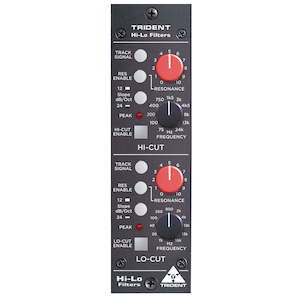Trident Audio Developments Hi-Lo 500 Tracking Filters

The Trident Hi-Lo, an adaptive Hi-Cut/Lo-Cut frequency filtering module that responds dynamically to program material, providing a high degree of control and signal enhancement, unavailable in any modern-day 500 series package. The Hi-Cut
This is a sweepable low pass filter with unity gain in the selected passband and a selectable (12dB per octave or 24dB per octave) roll-off outside the passband. The cutoff frequency can be set from 75Hz to 24kHz.
In addition, a RESONANCE control can be switched into circuit, to introduce a resonant peak at the selected cutoff frequency. The size of this peak, which is dependant on the elected frequency selected on the front panel, can be varied from zero to approximately 12dB. At maximum setting, RESONANCE stops just short of self-oscillation.
A HI-CUT ENABLE switch allows each individual frequency band or filter to be assessed, while a red PEAK warning indicator will illuminate at approximately 16dBu, approximately 12dBu below clipping. To allow adequate headroom, avoid boosting the signal by more than an amount which just causes this LED to flash on occasional peaks. Hi-Cut Dynamic Tracking
Using the TRACK SIGNAL function enables the Hi-Cut filter to be used for dynamic noise reduction. This is a technique that relies on the psychoacoustic effect of ‘masking’, in which a louder signal will cover up a quieter signal of the same frequency. In this mode, the cutoff frequency tracks dynamically the high frequency content of the music, with the FREQUENCY control setting the frequency to which the filter will close down in the absence of any high-frequency content.
With a noisy signal applied (e.g. from analog tape or other material with a high background noise content), start with the FREQUENCY control at maximum (fully clockwise) and back off the control until the noise just disappears.
Use of higher resonant settings will result in the movement of the filter becoming audible and indeed, combined with the lower settings of the FREQUENCY control, this can be the basis of some unique special effects. Further possibilities
The sweep range of the Hi-Cut filter is extremely wide, from effectively subsonic, right up to full audible bandwidth. This suggests the possibility of fading tracks in and out, not in the amplitude domain as is usual, but in the frequency domain. The Lo-Cut
This is a sweepable high pass filter with unity gain in the selected passband and selectable (12dB per octave or 24dB per octave) roll-off outside of the passband. The cutoff frequency can be set manually, anywhere from 15Hz to 16kHz.
In addition, a RESONANCE control can be switched into the circuit, to introduce a resonant peak at the selected cutoff frequency. The size of this peak, which is dependant on the elected frequency selected on the front panel, can be varied from zero to approximately 12dB. At maximum setting, RESONANCE stops just short of self-oscillation.
A LOW-CUT ENABLE switch allows each individual frequency band or filter to be assessed, while a red PEAK warning indicator will illuminate at approximately 16dBu, approximately 12dBu below clip-ping. To allow adequate headroom, avoid boosting the signal by more than an amount which just causes this LED to flash on occasional peaks. Lo-Cut Dynamic Tracking
Using the TRACK SIGNAL function, enables the Lo-Cut filter to be used for a dynamic hum or rumble reduction. This is a technique that relies on the psychoacoustic effect of ‘masking’, in which a louder signal will cover up a quieter signal of the same frequency. In this mode, the cut-off frequency tracks dynamically the low frequency content of the music, with the FREQUENCY control setting the frequency to which the filter will open up in the absence of any low-frequency content.
With a noisy signal applied (e.g. from a record deck or other material with a high background noise content), start with the FREQUENCY control at minimum (fully anticlockwise) and advance the control until the hum or rumble just disappears.
In practice, this technique demands a trade-off between noise reduction and loss of some low-frequency content of the program material. However, using the steepest (24dB per octave) slope maximizes the amount of low-frequency content retained. In addition, discreet use
of the RESONANCE control to introduce a small peak of a few dB at the cutoff frequency can psychoacoustically enhance the apparent bandwidth of the filtered signal. Use of higher resonant settings will result in the movement of the filter becoming audible and indeed, combined with higher settings of the FREQUENCY control, this can be
- Store:
- Oceania Audio Sales
- Price:
- $1,099
